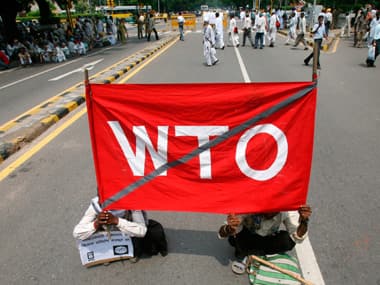New York: The chances of a trade deal look bleak after negotiators got close before they failed in Geneva to arrive at an underlying agreement before a crunch WTO ministerial summit next week in Bali, Indonesia. World Trade Organization chief Roberto Azevedo told reporters on Tuesday that diplomats from 159 member countries tried hard, but could not “cross the finish line here in Geneva” ahead of the summit. The ministers were to have signed the first deal in Bali, next week in more than a decade, which could have given the world economy a $1 trillion boost. [caption id=“attachment_1252265” align=“alignleft” width=“380”]  Representational image of WTO banner. Getty images[/caption] “This is not about shortness of time. If we had a few more weeks, we would still not make it,” Azevedo told a news conference. “If we are to get this deal over the line, we will need political engagement and political will,” he added. US trade ambassador Michael Punke gave a bleak assessment on Tuesday. “A once-in-a-generation opportunity may have slipped our grasp,” he told fellow negotiators. India is being blamed by some developed countries for making demands and objections that finally snookered the draft agreement. An official in India’s commerce ministry, however, said it was “too early to talk about a failure” and implied that even without some kind of text it was possible through ministerial-level discussions at Bali to have a successful outcome. This is optimistic, to say the least, because the lesson going back at least to Hong Kong 2005 is that if a basic understanding is not reached before hand, ministerial conferences can only end in frustration and failure. Trade facilitation deal The Bali conference is widely advertised as the “last gasp” of the WTO’s 12-year-old Doha round, launched in 2001 at a summit in Doha, Qatar. But negotiators had long ruled out the chances of Bali reviving the Doha Round and, instead, tried to draw up “mini-agreements” for the summit, which could be fed into a wider package later. On Tuesday, negotiators pored over a 53-page draft accord which still contained an array of bracketed options— standard diplomatic practice — which over recent weeks were cut from a thousand to 65. One covers “trade facilitation”, which involves simplifying customs procedures to ease commerce. A trade facilitation package would speed and standardise the flow of traded goods through customs posts and make tariff and non-tariff barriers more transparent. Analysts say trade facilitation could give the world economy a $1 trillion boost and create 18 million new jobs. India pushes food security Divisions there centre on the time-lag developing countries would get to fall into line, plus the support they would get from donors to do so. Another division is over “food security”, pushed by India. A number of large developing countries, led in this case by India, have demanded as a condition of signing-up for trade facilitation, exemptions from WTO limits on subsidised production and stockpiling of food crops. We all know Manmohan Singh’s government is about to embark on a massive food-support program that will deliver cheap rice and other grains to over 700 million people. Critics have warned the grains could end up on the open market, skewing global trade. India has sought immunity from complaints by other WTO members because countries like neighbouring Pakistan fear massive Indian dumping on their grain markets. Developed countries have offered a so-called peace clause, India and other developing countries undertaking similar food security programs would be safeguarded from WTO action for the next four years. India rejected the compromise, in effect demanding an indefinite opt-out. New Delhi is also opposed to several other conditions linked to annual disclosures about its public stockholding programme and curbs on exporting such stockholdings. Current regulations cap subsidies at 10 percent of the total value of the production of a food grain. India is worried it will breach this limit in the next few years, given the massive subsidy commitments it has embraced through the newly enacted food security law, which promises subsidized foodgrain to two-thirds of India’s population.
The chances of a trade deal look bleak after negotiators got close before they failed in Geneva to arrive at an underlying agreement before a crunch WTO ministerial summit next week in Bali, Indonesia
Advertisement
End of Article


)

)
)
)
)
)
)
)
)



